Dissertation: SCM and Organizational Performance in Telecomm Industry
VerifiedAdded on 2020/05/28
|86
|19883
|52
Thesis and Dissertation
AI Summary
This dissertation investigates the influence of supply chain management (SCM) practices on organizational performance, specifically within the Syrian telecommunication industry. The research examines the relationship between effective SCM processes and enhanced performance, considering the unique challenges and components of the service supply chain in this context. The study employs a mixed-method approach, incorporating both quantitative and qualitative data collection, including surveys and interviews with industry professionals. The dissertation explores the concepts, theories, and significance of SCM, while also addressing challenges and offering recommendations for future development. Key areas of focus include the impact of customer demand, technological advancements, supplier relationships, and the effects of the challenging regulatory environment. The study aims to provide insights into how the Syrian telecommunication industry can improve its SCM practices to boost organizational performance, strengthen stakeholder relationships, and navigate the complexities of the global market.
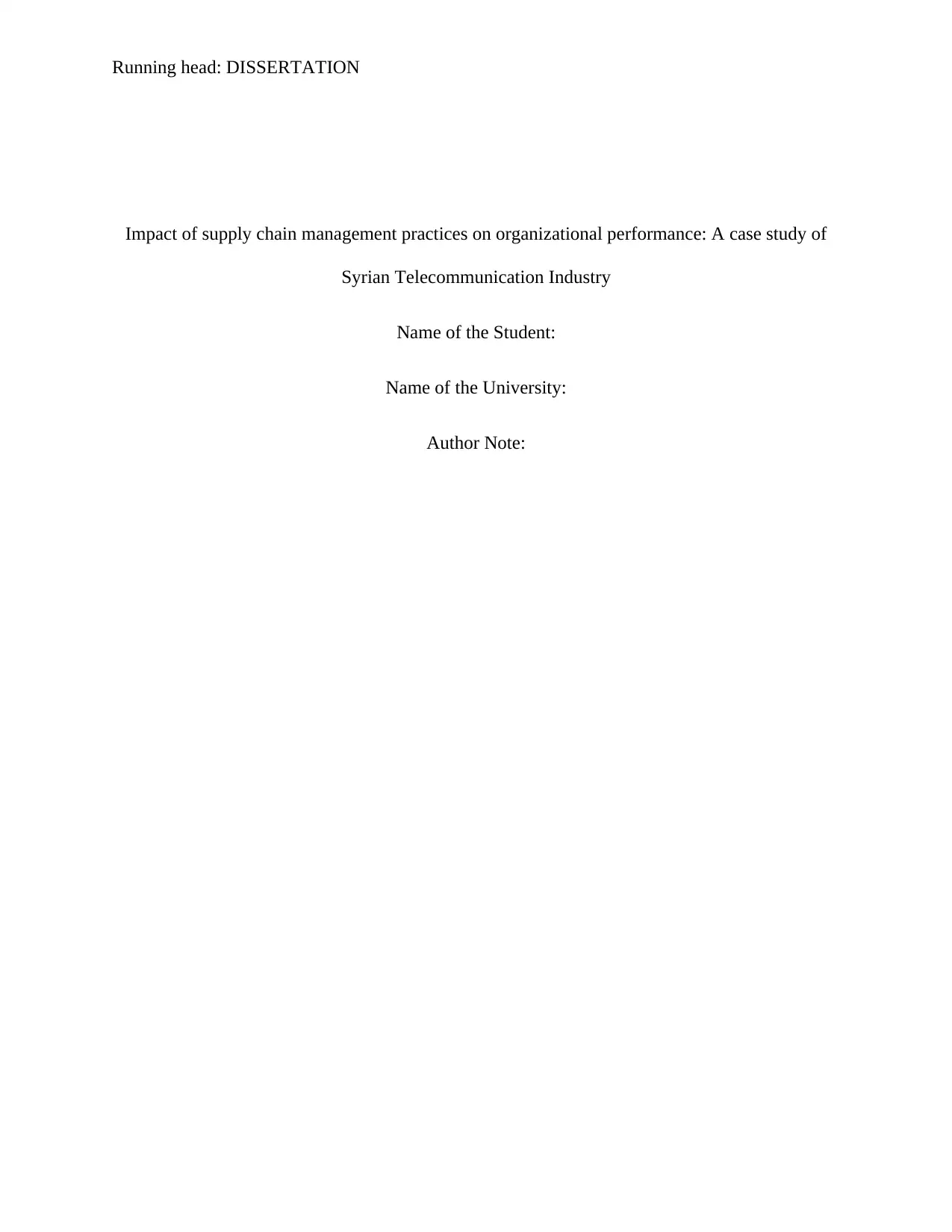
Running head: DISSERTATION
Impact of supply chain management practices on organizational performance: A case study of
Syrian Telecommunication Industry
Name of the Student:
Name of the University:
Author Note:
Impact of supply chain management practices on organizational performance: A case study of
Syrian Telecommunication Industry
Name of the Student:
Name of the University:
Author Note:
Paraphrase This Document
Need a fresh take? Get an instant paraphrase of this document with our AI Paraphraser
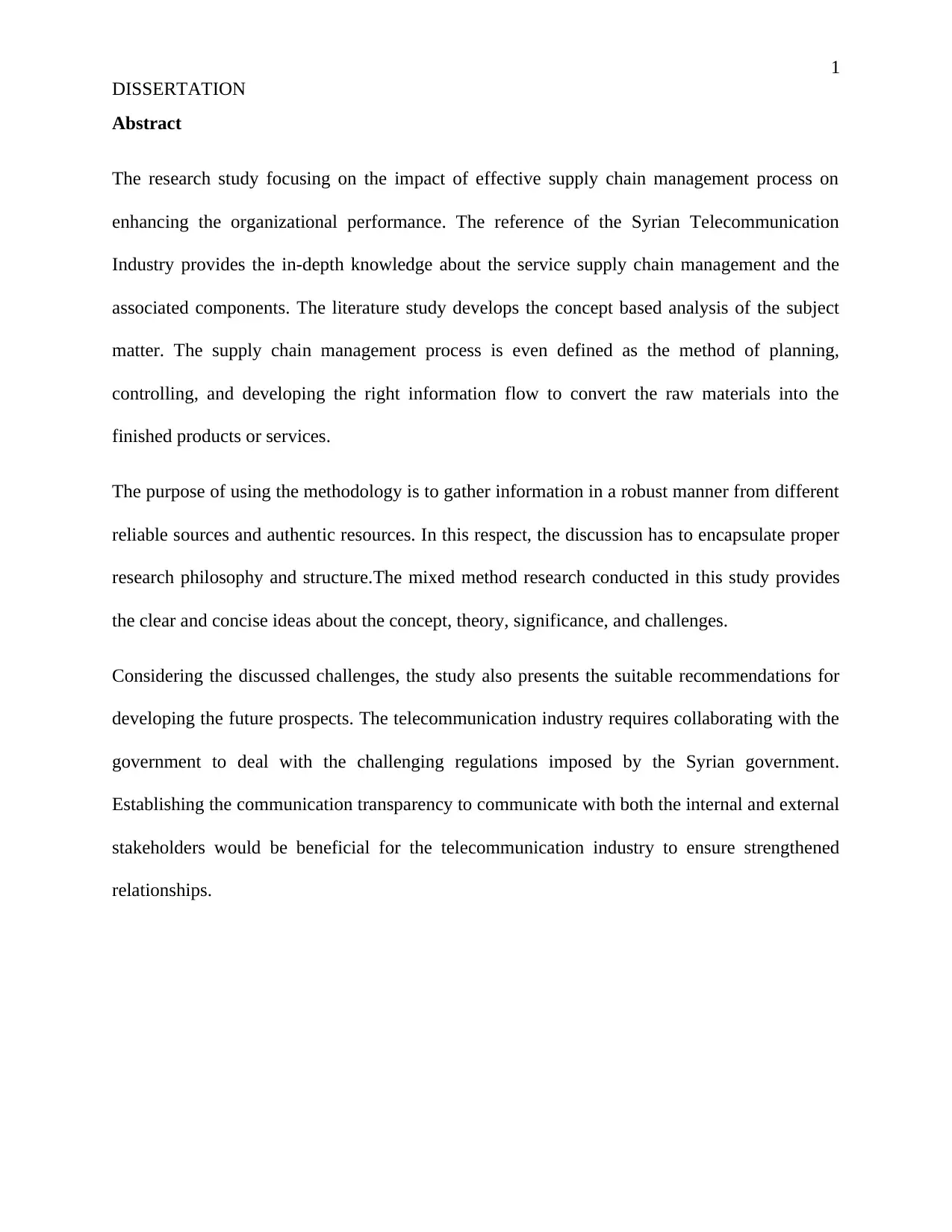
1
DISSERTATION
Abstract
The research study focusing on the impact of effective supply chain management process on
enhancing the organizational performance. The reference of the Syrian Telecommunication
Industry provides the in-depth knowledge about the service supply chain management and the
associated components. The literature study develops the concept based analysis of the subject
matter. The supply chain management process is even defined as the method of planning,
controlling, and developing the right information flow to convert the raw materials into the
finished products or services.
The purpose of using the methodology is to gather information in a robust manner from different
reliable sources and authentic resources. In this respect, the discussion has to encapsulate proper
research philosophy and structure.The mixed method research conducted in this study provides
the clear and concise ideas about the concept, theory, significance, and challenges.
Considering the discussed challenges, the study also presents the suitable recommendations for
developing the future prospects. The telecommunication industry requires collaborating with the
government to deal with the challenging regulations imposed by the Syrian government.
Establishing the communication transparency to communicate with both the internal and external
stakeholders would be beneficial for the telecommunication industry to ensure strengthened
relationships.
DISSERTATION
Abstract
The research study focusing on the impact of effective supply chain management process on
enhancing the organizational performance. The reference of the Syrian Telecommunication
Industry provides the in-depth knowledge about the service supply chain management and the
associated components. The literature study develops the concept based analysis of the subject
matter. The supply chain management process is even defined as the method of planning,
controlling, and developing the right information flow to convert the raw materials into the
finished products or services.
The purpose of using the methodology is to gather information in a robust manner from different
reliable sources and authentic resources. In this respect, the discussion has to encapsulate proper
research philosophy and structure.The mixed method research conducted in this study provides
the clear and concise ideas about the concept, theory, significance, and challenges.
Considering the discussed challenges, the study also presents the suitable recommendations for
developing the future prospects. The telecommunication industry requires collaborating with the
government to deal with the challenging regulations imposed by the Syrian government.
Establishing the communication transparency to communicate with both the internal and external
stakeholders would be beneficial for the telecommunication industry to ensure strengthened
relationships.
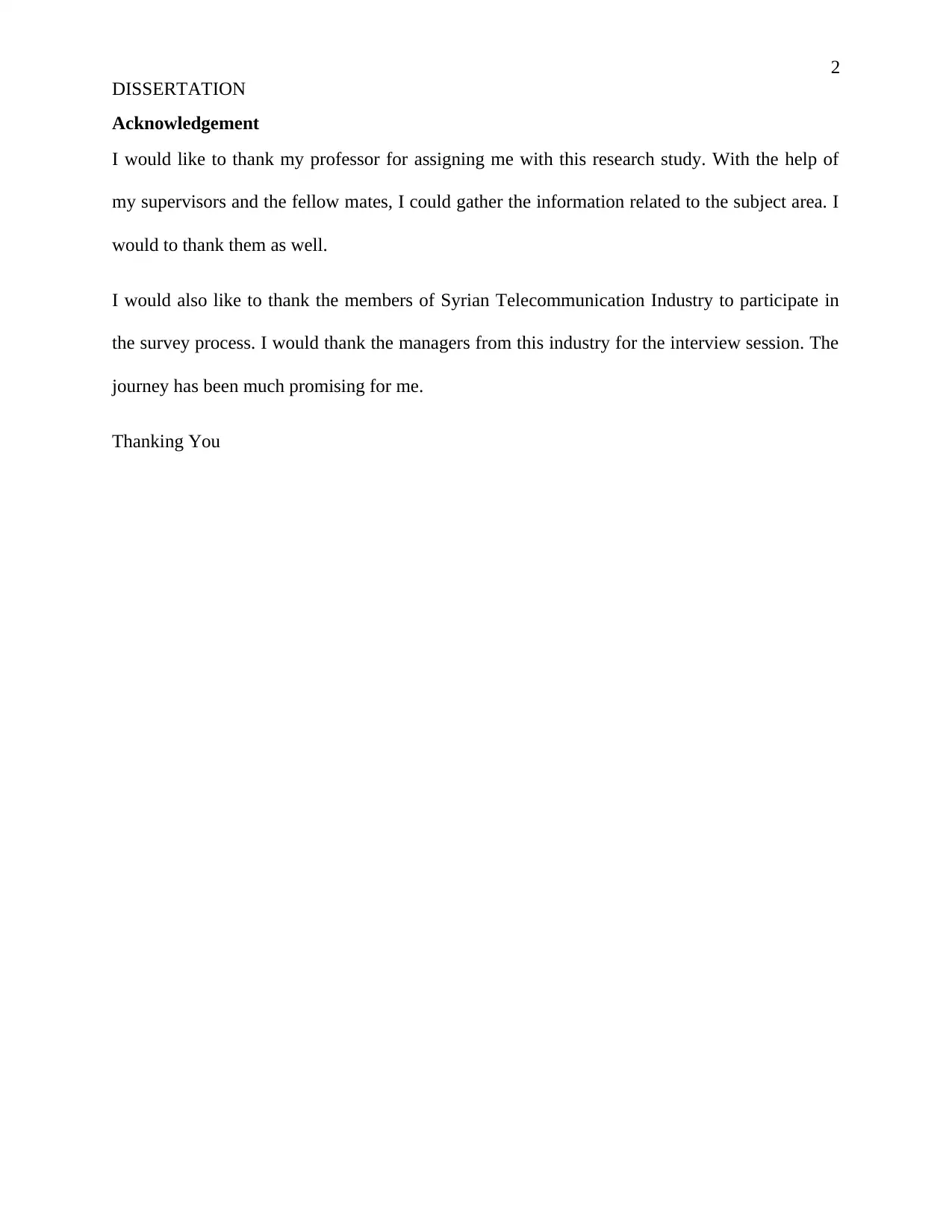
2
DISSERTATION
Acknowledgement
I would like to thank my professor for assigning me with this research study. With the help of
my supervisors and the fellow mates, I could gather the information related to the subject area. I
would to thank them as well.
I would also like to thank the members of Syrian Telecommunication Industry to participate in
the survey process. I would thank the managers from this industry for the interview session. The
journey has been much promising for me.
Thanking You
DISSERTATION
Acknowledgement
I would like to thank my professor for assigning me with this research study. With the help of
my supervisors and the fellow mates, I could gather the information related to the subject area. I
would to thank them as well.
I would also like to thank the members of Syrian Telecommunication Industry to participate in
the survey process. I would thank the managers from this industry for the interview session. The
journey has been much promising for me.
Thanking You
⊘ This is a preview!⊘
Do you want full access?
Subscribe today to unlock all pages.

Trusted by 1+ million students worldwide
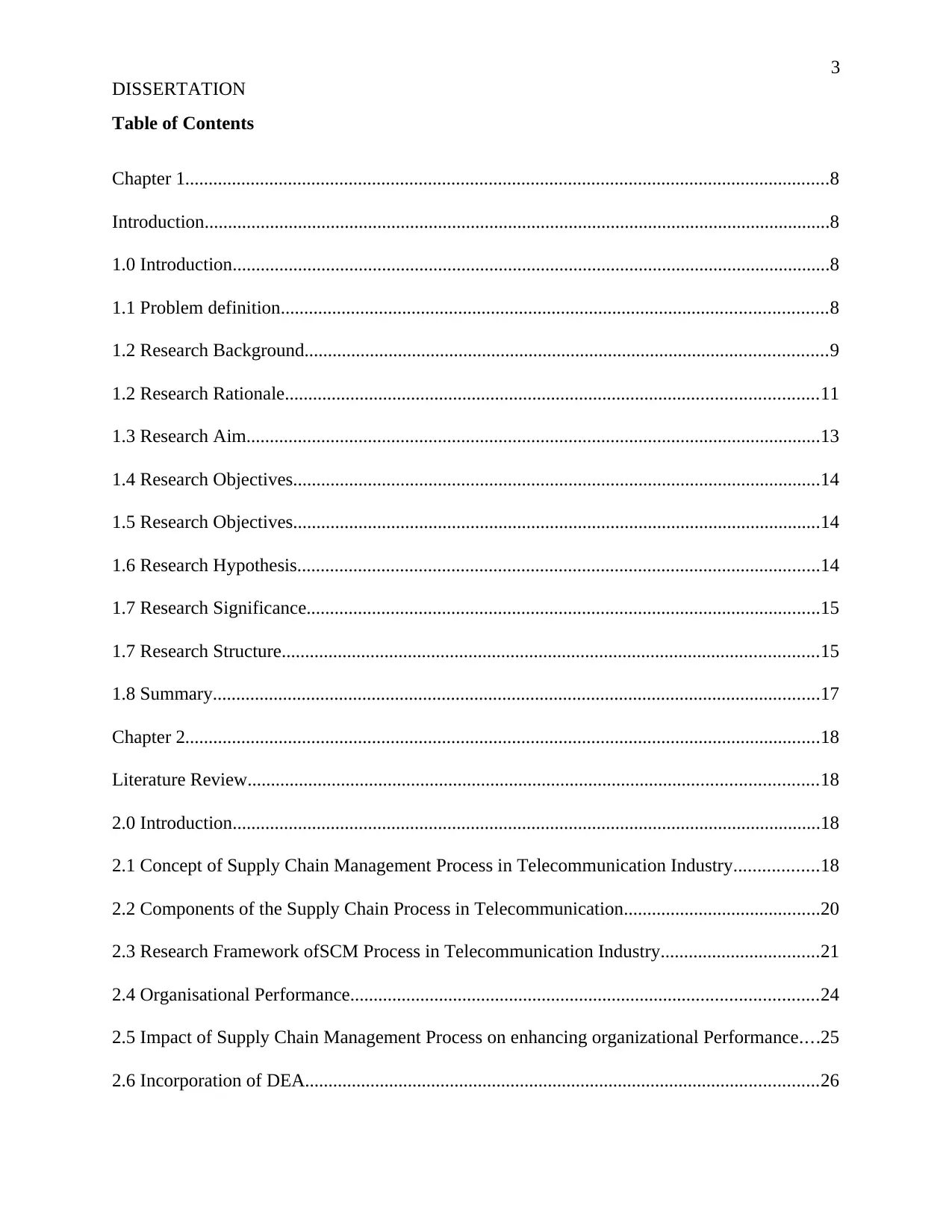
3
DISSERTATION
Table of Contents
Chapter 1..........................................................................................................................................8
Introduction......................................................................................................................................8
1.0 Introduction................................................................................................................................8
1.1 Problem definition.....................................................................................................................8
1.2 Research Background................................................................................................................9
1.2 Research Rationale..................................................................................................................11
1.3 Research Aim...........................................................................................................................13
1.4 Research Objectives.................................................................................................................14
1.5 Research Objectives.................................................................................................................14
1.6 Research Hypothesis................................................................................................................14
1.7 Research Significance..............................................................................................................15
1.7 Research Structure...................................................................................................................15
1.8 Summary..................................................................................................................................17
Chapter 2........................................................................................................................................18
Literature Review..........................................................................................................................18
2.0 Introduction..............................................................................................................................18
2.1 Concept of Supply Chain Management Process in Telecommunication Industry..................18
2.2 Components of the Supply Chain Process in Telecommunication..........................................20
2.3 Research Framework ofSCM Process in Telecommunication Industry..................................21
2.4 Organisational Performance....................................................................................................24
2.5 Impact of Supply Chain Management Process on enhancing organizational Performance....25
2.6 Incorporation of DEA..............................................................................................................26
DISSERTATION
Table of Contents
Chapter 1..........................................................................................................................................8
Introduction......................................................................................................................................8
1.0 Introduction................................................................................................................................8
1.1 Problem definition.....................................................................................................................8
1.2 Research Background................................................................................................................9
1.2 Research Rationale..................................................................................................................11
1.3 Research Aim...........................................................................................................................13
1.4 Research Objectives.................................................................................................................14
1.5 Research Objectives.................................................................................................................14
1.6 Research Hypothesis................................................................................................................14
1.7 Research Significance..............................................................................................................15
1.7 Research Structure...................................................................................................................15
1.8 Summary..................................................................................................................................17
Chapter 2........................................................................................................................................18
Literature Review..........................................................................................................................18
2.0 Introduction..............................................................................................................................18
2.1 Concept of Supply Chain Management Process in Telecommunication Industry..................18
2.2 Components of the Supply Chain Process in Telecommunication..........................................20
2.3 Research Framework ofSCM Process in Telecommunication Industry..................................21
2.4 Organisational Performance....................................................................................................24
2.5 Impact of Supply Chain Management Process on enhancing organizational Performance....25
2.6 Incorporation of DEA..............................................................................................................26
Paraphrase This Document
Need a fresh take? Get an instant paraphrase of this document with our AI Paraphraser
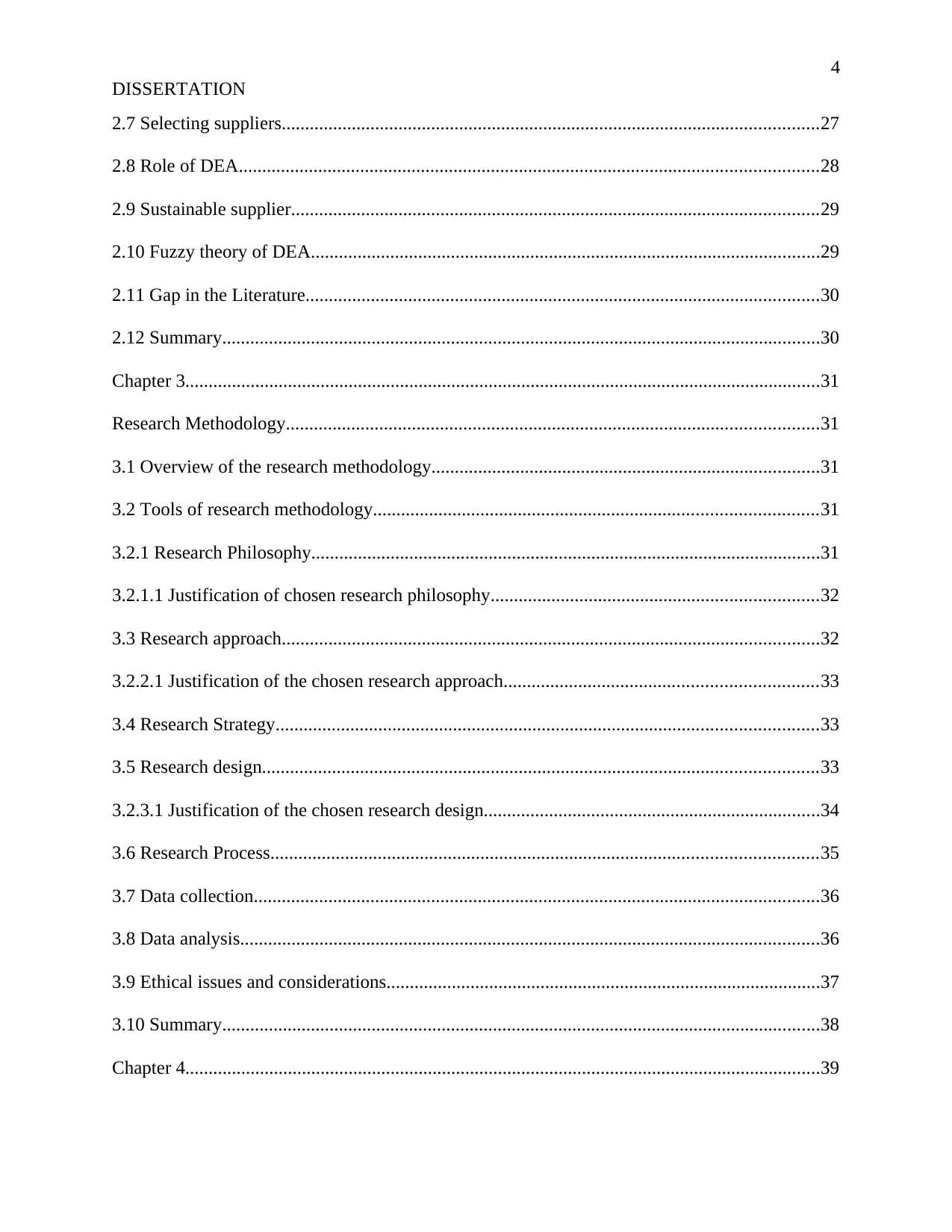
4
DISSERTATION
2.7 Selecting suppliers...................................................................................................................27
2.8 Role of DEA............................................................................................................................28
2.9 Sustainable supplier.................................................................................................................29
2.10 Fuzzy theory of DEA.............................................................................................................29
2.11 Gap in the Literature..............................................................................................................30
2.12 Summary................................................................................................................................30
Chapter 3........................................................................................................................................31
Research Methodology..................................................................................................................31
3.1 Overview of the research methodology...................................................................................31
3.2 Tools of research methodology...............................................................................................31
3.2.1 Research Philosophy.............................................................................................................31
3.2.1.1 Justification of chosen research philosophy......................................................................32
3.3 Research approach...................................................................................................................32
3.2.2.1 Justification of the chosen research approach...................................................................33
3.4 Research Strategy....................................................................................................................33
3.5 Research design.......................................................................................................................33
3.2.3.1 Justification of the chosen research design........................................................................34
3.6 Research Process.....................................................................................................................35
3.7 Data collection.........................................................................................................................36
3.8 Data analysis............................................................................................................................36
3.9 Ethical issues and considerations.............................................................................................37
3.10 Summary................................................................................................................................38
Chapter 4........................................................................................................................................39
DISSERTATION
2.7 Selecting suppliers...................................................................................................................27
2.8 Role of DEA............................................................................................................................28
2.9 Sustainable supplier.................................................................................................................29
2.10 Fuzzy theory of DEA.............................................................................................................29
2.11 Gap in the Literature..............................................................................................................30
2.12 Summary................................................................................................................................30
Chapter 3........................................................................................................................................31
Research Methodology..................................................................................................................31
3.1 Overview of the research methodology...................................................................................31
3.2 Tools of research methodology...............................................................................................31
3.2.1 Research Philosophy.............................................................................................................31
3.2.1.1 Justification of chosen research philosophy......................................................................32
3.3 Research approach...................................................................................................................32
3.2.2.1 Justification of the chosen research approach...................................................................33
3.4 Research Strategy....................................................................................................................33
3.5 Research design.......................................................................................................................33
3.2.3.1 Justification of the chosen research design........................................................................34
3.6 Research Process.....................................................................................................................35
3.7 Data collection.........................................................................................................................36
3.8 Data analysis............................................................................................................................36
3.9 Ethical issues and considerations.............................................................................................37
3.10 Summary................................................................................................................................38
Chapter 4........................................................................................................................................39
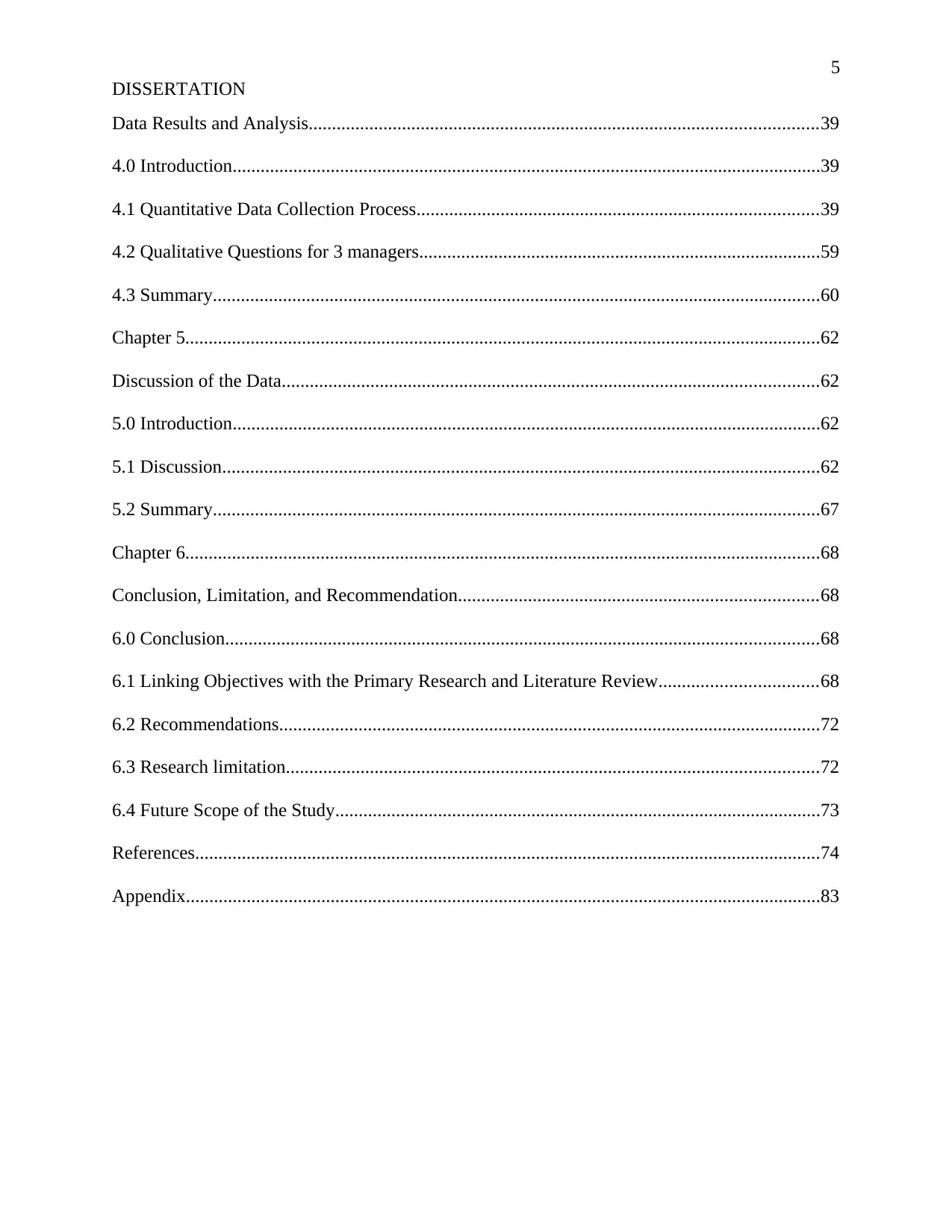
5
DISSERTATION
Data Results and Analysis.............................................................................................................39
4.0 Introduction..............................................................................................................................39
4.1 Quantitative Data Collection Process......................................................................................39
4.2 Qualitative Questions for 3 managers......................................................................................59
4.3 Summary..................................................................................................................................60
Chapter 5........................................................................................................................................62
Discussion of the Data...................................................................................................................62
5.0 Introduction..............................................................................................................................62
5.1 Discussion................................................................................................................................62
5.2 Summary..................................................................................................................................67
Chapter 6........................................................................................................................................68
Conclusion, Limitation, and Recommendation.............................................................................68
6.0 Conclusion...............................................................................................................................68
6.1 Linking Objectives with the Primary Research and Literature Review..................................68
6.2 Recommendations....................................................................................................................72
6.3 Research limitation..................................................................................................................72
6.4 Future Scope of the Study........................................................................................................73
References......................................................................................................................................74
Appendix........................................................................................................................................83
DISSERTATION
Data Results and Analysis.............................................................................................................39
4.0 Introduction..............................................................................................................................39
4.1 Quantitative Data Collection Process......................................................................................39
4.2 Qualitative Questions for 3 managers......................................................................................59
4.3 Summary..................................................................................................................................60
Chapter 5........................................................................................................................................62
Discussion of the Data...................................................................................................................62
5.0 Introduction..............................................................................................................................62
5.1 Discussion................................................................................................................................62
5.2 Summary..................................................................................................................................67
Chapter 6........................................................................................................................................68
Conclusion, Limitation, and Recommendation.............................................................................68
6.0 Conclusion...............................................................................................................................68
6.1 Linking Objectives with the Primary Research and Literature Review..................................68
6.2 Recommendations....................................................................................................................72
6.3 Research limitation..................................................................................................................72
6.4 Future Scope of the Study........................................................................................................73
References......................................................................................................................................74
Appendix........................................................................................................................................83
⊘ This is a preview!⊘
Do you want full access?
Subscribe today to unlock all pages.

Trusted by 1+ million students worldwide
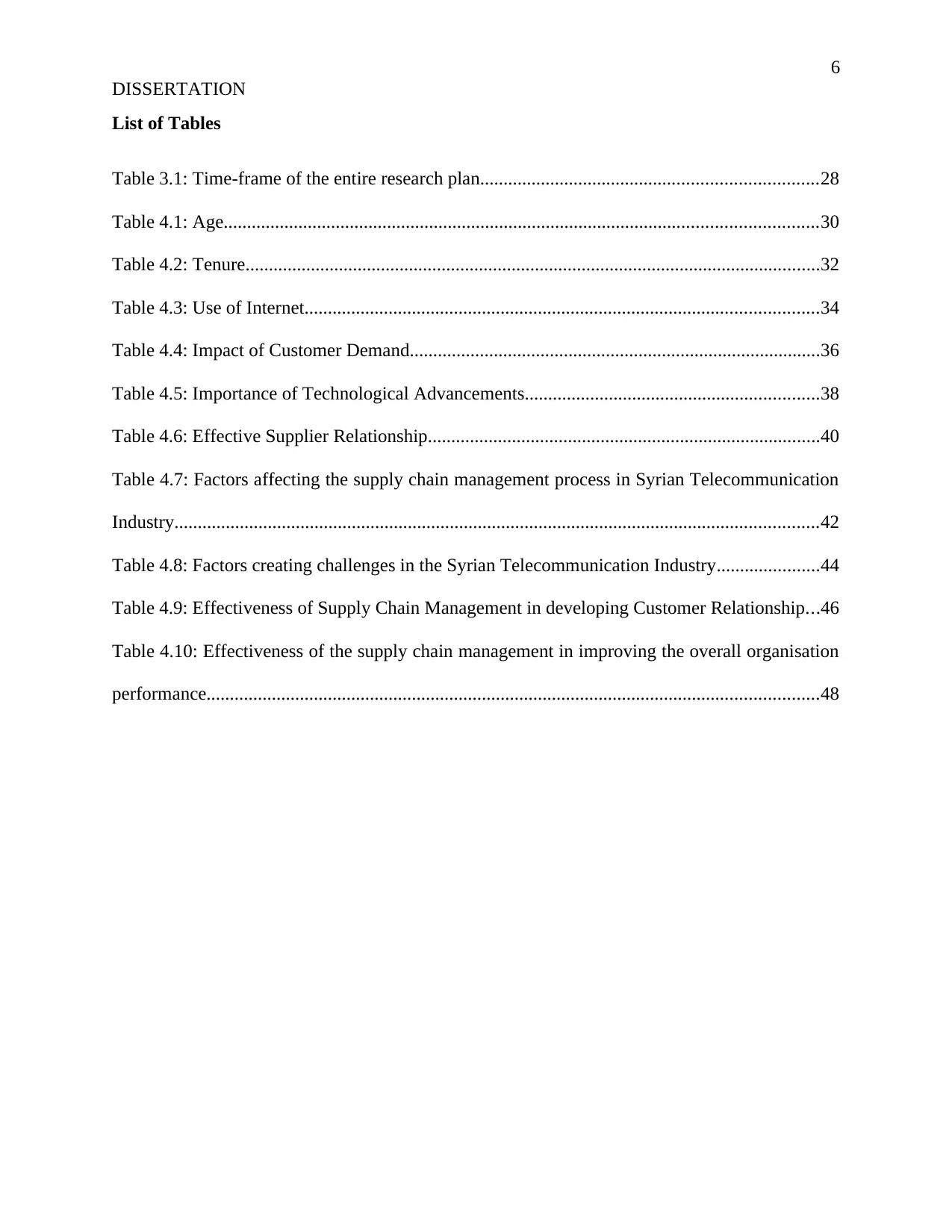
6
DISSERTATION
List of Tables
Table 3.1: Time-frame of the entire research plan........................................................................28
Table 4.1: Age...............................................................................................................................30
Table 4.2: Tenure...........................................................................................................................32
Table 4.3: Use of Internet..............................................................................................................34
Table 4.4: Impact of Customer Demand........................................................................................36
Table 4.5: Importance of Technological Advancements...............................................................38
Table 4.6: Effective Supplier Relationship....................................................................................40
Table 4.7: Factors affecting the supply chain management process in Syrian Telecommunication
Industry..........................................................................................................................................42
Table 4.8: Factors creating challenges in the Syrian Telecommunication Industry......................44
Table 4.9: Effectiveness of Supply Chain Management in developing Customer Relationship...46
Table 4.10: Effectiveness of the supply chain management in improving the overall organisation
performance...................................................................................................................................48
DISSERTATION
List of Tables
Table 3.1: Time-frame of the entire research plan........................................................................28
Table 4.1: Age...............................................................................................................................30
Table 4.2: Tenure...........................................................................................................................32
Table 4.3: Use of Internet..............................................................................................................34
Table 4.4: Impact of Customer Demand........................................................................................36
Table 4.5: Importance of Technological Advancements...............................................................38
Table 4.6: Effective Supplier Relationship....................................................................................40
Table 4.7: Factors affecting the supply chain management process in Syrian Telecommunication
Industry..........................................................................................................................................42
Table 4.8: Factors creating challenges in the Syrian Telecommunication Industry......................44
Table 4.9: Effectiveness of Supply Chain Management in developing Customer Relationship...46
Table 4.10: Effectiveness of the supply chain management in improving the overall organisation
performance...................................................................................................................................48
Paraphrase This Document
Need a fresh take? Get an instant paraphrase of this document with our AI Paraphraser
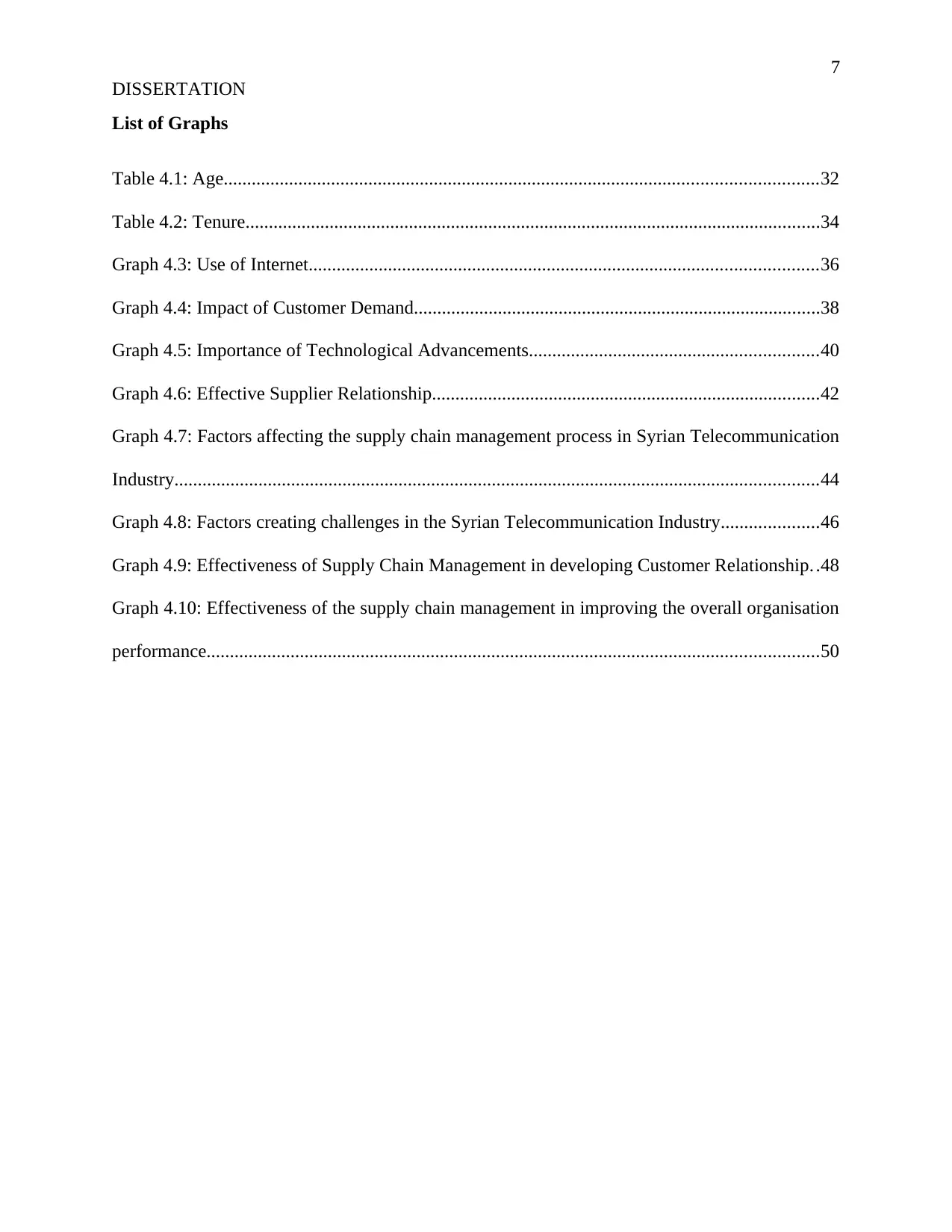
7
DISSERTATION
List of Graphs
Table 4.1: Age...............................................................................................................................32
Table 4.2: Tenure...........................................................................................................................34
Graph 4.3: Use of Internet.............................................................................................................36
Graph 4.4: Impact of Customer Demand.......................................................................................38
Graph 4.5: Importance of Technological Advancements..............................................................40
Graph 4.6: Effective Supplier Relationship...................................................................................42
Graph 4.7: Factors affecting the supply chain management process in Syrian Telecommunication
Industry..........................................................................................................................................44
Graph 4.8: Factors creating challenges in the Syrian Telecommunication Industry.....................46
Graph 4.9: Effectiveness of Supply Chain Management in developing Customer Relationship. .48
Graph 4.10: Effectiveness of the supply chain management in improving the overall organisation
performance...................................................................................................................................50
DISSERTATION
List of Graphs
Table 4.1: Age...............................................................................................................................32
Table 4.2: Tenure...........................................................................................................................34
Graph 4.3: Use of Internet.............................................................................................................36
Graph 4.4: Impact of Customer Demand.......................................................................................38
Graph 4.5: Importance of Technological Advancements..............................................................40
Graph 4.6: Effective Supplier Relationship...................................................................................42
Graph 4.7: Factors affecting the supply chain management process in Syrian Telecommunication
Industry..........................................................................................................................................44
Graph 4.8: Factors creating challenges in the Syrian Telecommunication Industry.....................46
Graph 4.9: Effectiveness of Supply Chain Management in developing Customer Relationship. .48
Graph 4.10: Effectiveness of the supply chain management in improving the overall organisation
performance...................................................................................................................................50
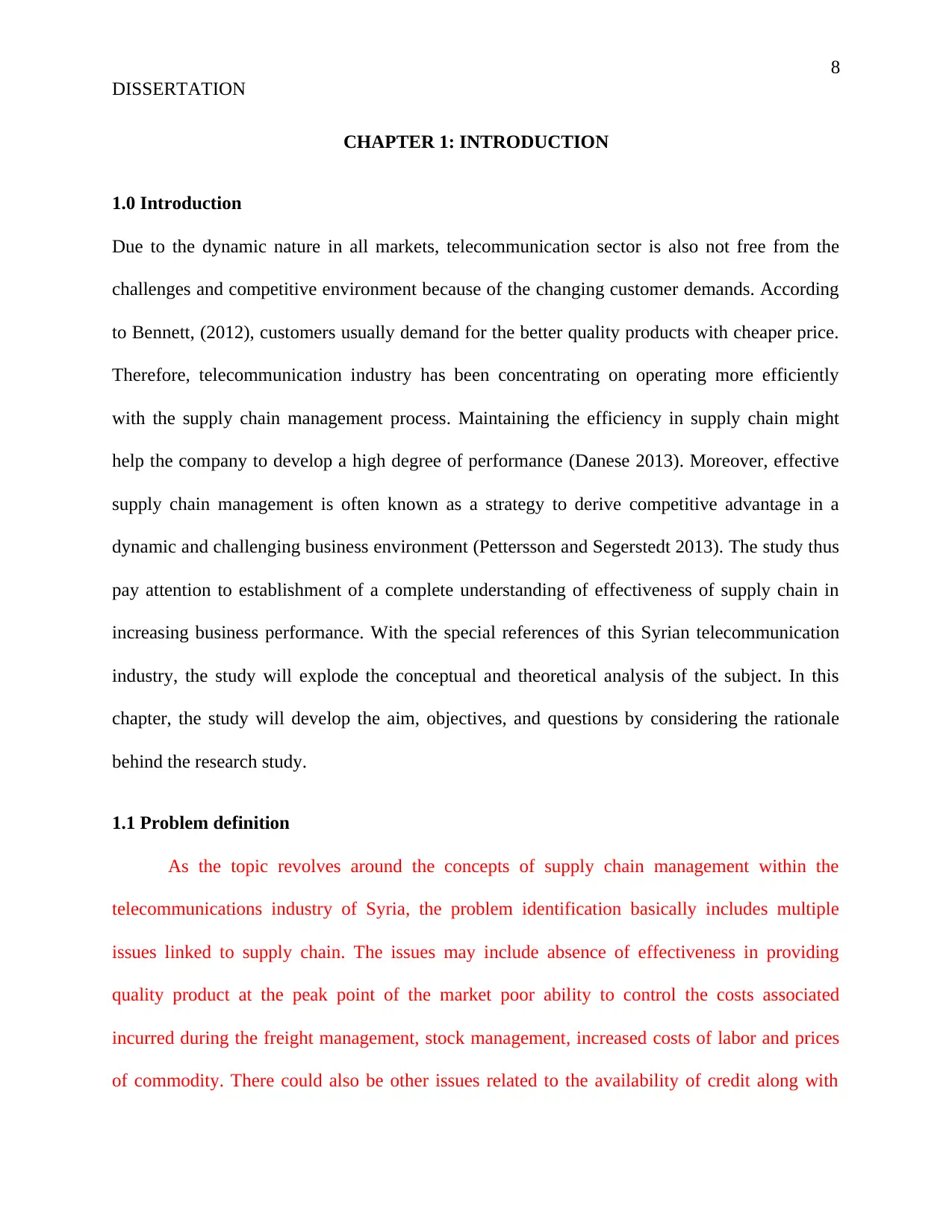
8
DISSERTATION
CHAPTER 1: INTRODUCTION
1.0 Introduction
Due to the dynamic nature in all markets, telecommunication sector is also not free from the
challenges and competitive environment because of the changing customer demands. According
to Bennett, (2012), customers usually demand for the better quality products with cheaper price.
Therefore, telecommunication industry has been concentrating on operating more efficiently
with the supply chain management process. Maintaining the efficiency in supply chain might
help the company to develop a high degree of performance (Danese 2013). Moreover, effective
supply chain management is often known as a strategy to derive competitive advantage in a
dynamic and challenging business environment (Pettersson and Segerstedt 2013). The study thus
pay attention to establishment of a complete understanding of effectiveness of supply chain in
increasing business performance. With the special references of this Syrian telecommunication
industry, the study will explode the conceptual and theoretical analysis of the subject. In this
chapter, the study will develop the aim, objectives, and questions by considering the rationale
behind the research study.
1.1 Problem definition
As the topic revolves around the concepts of supply chain management within the
telecommunications industry of Syria, the problem identification basically includes multiple
issues linked to supply chain. The issues may include absence of effectiveness in providing
quality product at the peak point of the market poor ability to control the costs associated
incurred during the freight management, stock management, increased costs of labor and prices
of commodity. There could also be other issues related to the availability of credit along with
DISSERTATION
CHAPTER 1: INTRODUCTION
1.0 Introduction
Due to the dynamic nature in all markets, telecommunication sector is also not free from the
challenges and competitive environment because of the changing customer demands. According
to Bennett, (2012), customers usually demand for the better quality products with cheaper price.
Therefore, telecommunication industry has been concentrating on operating more efficiently
with the supply chain management process. Maintaining the efficiency in supply chain might
help the company to develop a high degree of performance (Danese 2013). Moreover, effective
supply chain management is often known as a strategy to derive competitive advantage in a
dynamic and challenging business environment (Pettersson and Segerstedt 2013). The study thus
pay attention to establishment of a complete understanding of effectiveness of supply chain in
increasing business performance. With the special references of this Syrian telecommunication
industry, the study will explode the conceptual and theoretical analysis of the subject. In this
chapter, the study will develop the aim, objectives, and questions by considering the rationale
behind the research study.
1.1 Problem definition
As the topic revolves around the concepts of supply chain management within the
telecommunications industry of Syria, the problem identification basically includes multiple
issues linked to supply chain. The issues may include absence of effectiveness in providing
quality product at the peak point of the market poor ability to control the costs associated
incurred during the freight management, stock management, increased costs of labor and prices
of commodity. There could also be other issues related to the availability of credit along with
⊘ This is a preview!⊘
Do you want full access?
Subscribe today to unlock all pages.

Trusted by 1+ million students worldwide
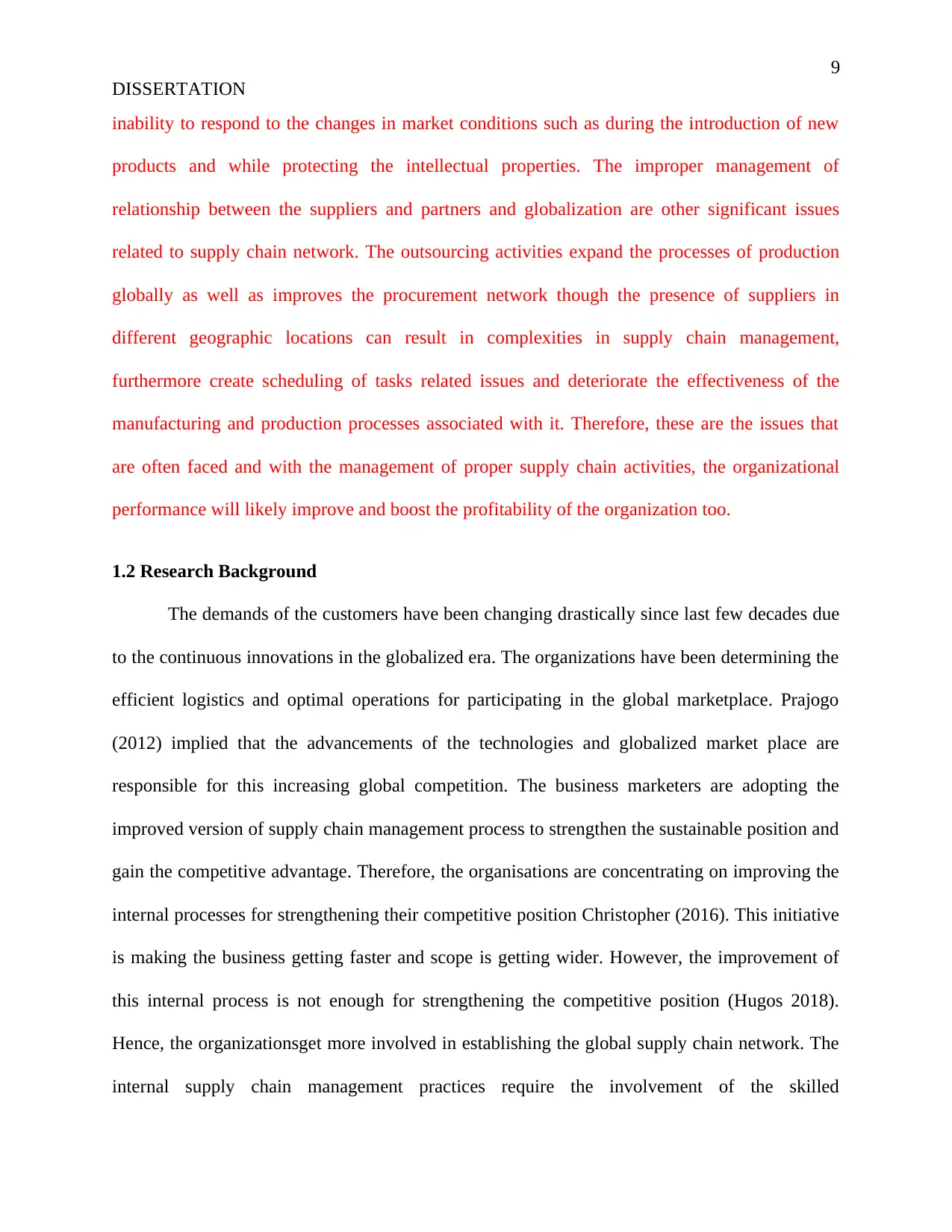
9
DISSERTATION
inability to respond to the changes in market conditions such as during the introduction of new
products and while protecting the intellectual properties. The improper management of
relationship between the suppliers and partners and globalization are other significant issues
related to supply chain network. The outsourcing activities expand the processes of production
globally as well as improves the procurement network though the presence of suppliers in
different geographic locations can result in complexities in supply chain management,
furthermore create scheduling of tasks related issues and deteriorate the effectiveness of the
manufacturing and production processes associated with it. Therefore, these are the issues that
are often faced and with the management of proper supply chain activities, the organizational
performance will likely improve and boost the profitability of the organization too.
1.2 Research Background
The demands of the customers have been changing drastically since last few decades due
to the continuous innovations in the globalized era. The organizations have been determining the
efficient logistics and optimal operations for participating in the global marketplace. Prajogo
(2012) implied that the advancements of the technologies and globalized market place are
responsible for this increasing global competition. The business marketers are adopting the
improved version of supply chain management process to strengthen the sustainable position and
gain the competitive advantage. Therefore, the organisations are concentrating on improving the
internal processes for strengthening their competitive position Christopher (2016). This initiative
is making the business getting faster and scope is getting wider. However, the improvement of
this internal process is not enough for strengthening the competitive position (Hugos 2018).
Hence, the organizationsget more involved in establishing the global supply chain network. The
internal supply chain management practices require the involvement of the skilled
DISSERTATION
inability to respond to the changes in market conditions such as during the introduction of new
products and while protecting the intellectual properties. The improper management of
relationship between the suppliers and partners and globalization are other significant issues
related to supply chain network. The outsourcing activities expand the processes of production
globally as well as improves the procurement network though the presence of suppliers in
different geographic locations can result in complexities in supply chain management,
furthermore create scheduling of tasks related issues and deteriorate the effectiveness of the
manufacturing and production processes associated with it. Therefore, these are the issues that
are often faced and with the management of proper supply chain activities, the organizational
performance will likely improve and boost the profitability of the organization too.
1.2 Research Background
The demands of the customers have been changing drastically since last few decades due
to the continuous innovations in the globalized era. The organizations have been determining the
efficient logistics and optimal operations for participating in the global marketplace. Prajogo
(2012) implied that the advancements of the technologies and globalized market place are
responsible for this increasing global competition. The business marketers are adopting the
improved version of supply chain management process to strengthen the sustainable position and
gain the competitive advantage. Therefore, the organisations are concentrating on improving the
internal processes for strengthening their competitive position Christopher (2016). This initiative
is making the business getting faster and scope is getting wider. However, the improvement of
this internal process is not enough for strengthening the competitive position (Hugos 2018).
Hence, the organizationsget more involved in establishing the global supply chain network. The
internal supply chain management practices require the involvement of the skilled
Paraphrase This Document
Need a fresh take? Get an instant paraphrase of this document with our AI Paraphraser
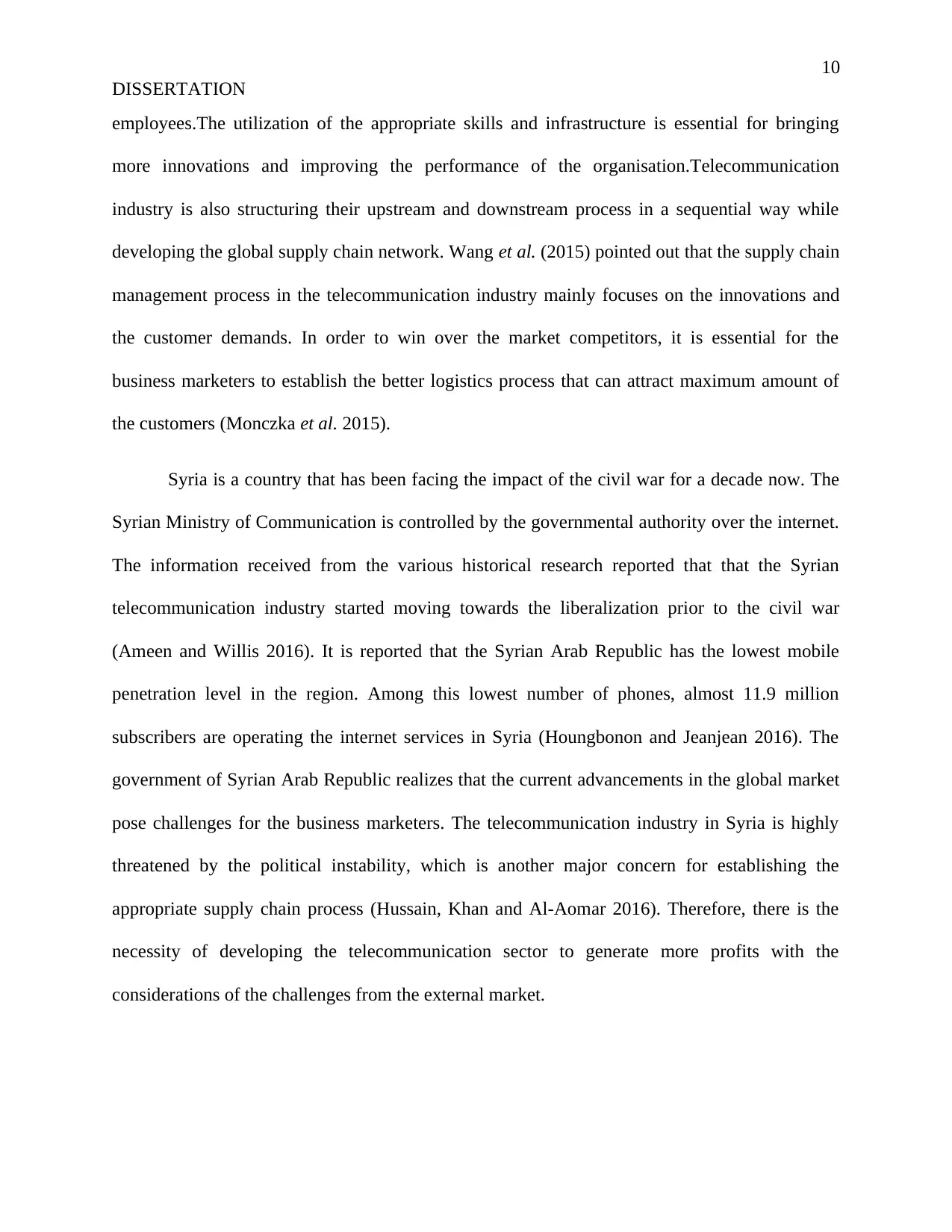
10
DISSERTATION
employees.The utilization of the appropriate skills and infrastructure is essential for bringing
more innovations and improving the performance of the organisation.Telecommunication
industry is also structuring their upstream and downstream process in a sequential way while
developing the global supply chain network. Wang et al. (2015) pointed out that the supply chain
management process in the telecommunication industry mainly focuses on the innovations and
the customer demands. In order to win over the market competitors, it is essential for the
business marketers to establish the better logistics process that can attract maximum amount of
the customers (Monczka et al. 2015).
Syria is a country that has been facing the impact of the civil war for a decade now. The
Syrian Ministry of Communication is controlled by the governmental authority over the internet.
The information received from the various historical research reported that that the Syrian
telecommunication industry started moving towards the liberalization prior to the civil war
(Ameen and Willis 2016). It is reported that the Syrian Arab Republic has the lowest mobile
penetration level in the region. Among this lowest number of phones, almost 11.9 million
subscribers are operating the internet services in Syria (Houngbonon and Jeanjean 2016). The
government of Syrian Arab Republic realizes that the current advancements in the global market
pose challenges for the business marketers. The telecommunication industry in Syria is highly
threatened by the political instability, which is another major concern for establishing the
appropriate supply chain process (Hussain, Khan and Al-Aomar 2016). Therefore, there is the
necessity of developing the telecommunication sector to generate more profits with the
considerations of the challenges from the external market.
DISSERTATION
employees.The utilization of the appropriate skills and infrastructure is essential for bringing
more innovations and improving the performance of the organisation.Telecommunication
industry is also structuring their upstream and downstream process in a sequential way while
developing the global supply chain network. Wang et al. (2015) pointed out that the supply chain
management process in the telecommunication industry mainly focuses on the innovations and
the customer demands. In order to win over the market competitors, it is essential for the
business marketers to establish the better logistics process that can attract maximum amount of
the customers (Monczka et al. 2015).
Syria is a country that has been facing the impact of the civil war for a decade now. The
Syrian Ministry of Communication is controlled by the governmental authority over the internet.
The information received from the various historical research reported that that the Syrian
telecommunication industry started moving towards the liberalization prior to the civil war
(Ameen and Willis 2016). It is reported that the Syrian Arab Republic has the lowest mobile
penetration level in the region. Among this lowest number of phones, almost 11.9 million
subscribers are operating the internet services in Syria (Houngbonon and Jeanjean 2016). The
government of Syrian Arab Republic realizes that the current advancements in the global market
pose challenges for the business marketers. The telecommunication industry in Syria is highly
threatened by the political instability, which is another major concern for establishing the
appropriate supply chain process (Hussain, Khan and Al-Aomar 2016). Therefore, there is the
necessity of developing the telecommunication sector to generate more profits with the
considerations of the challenges from the external market.
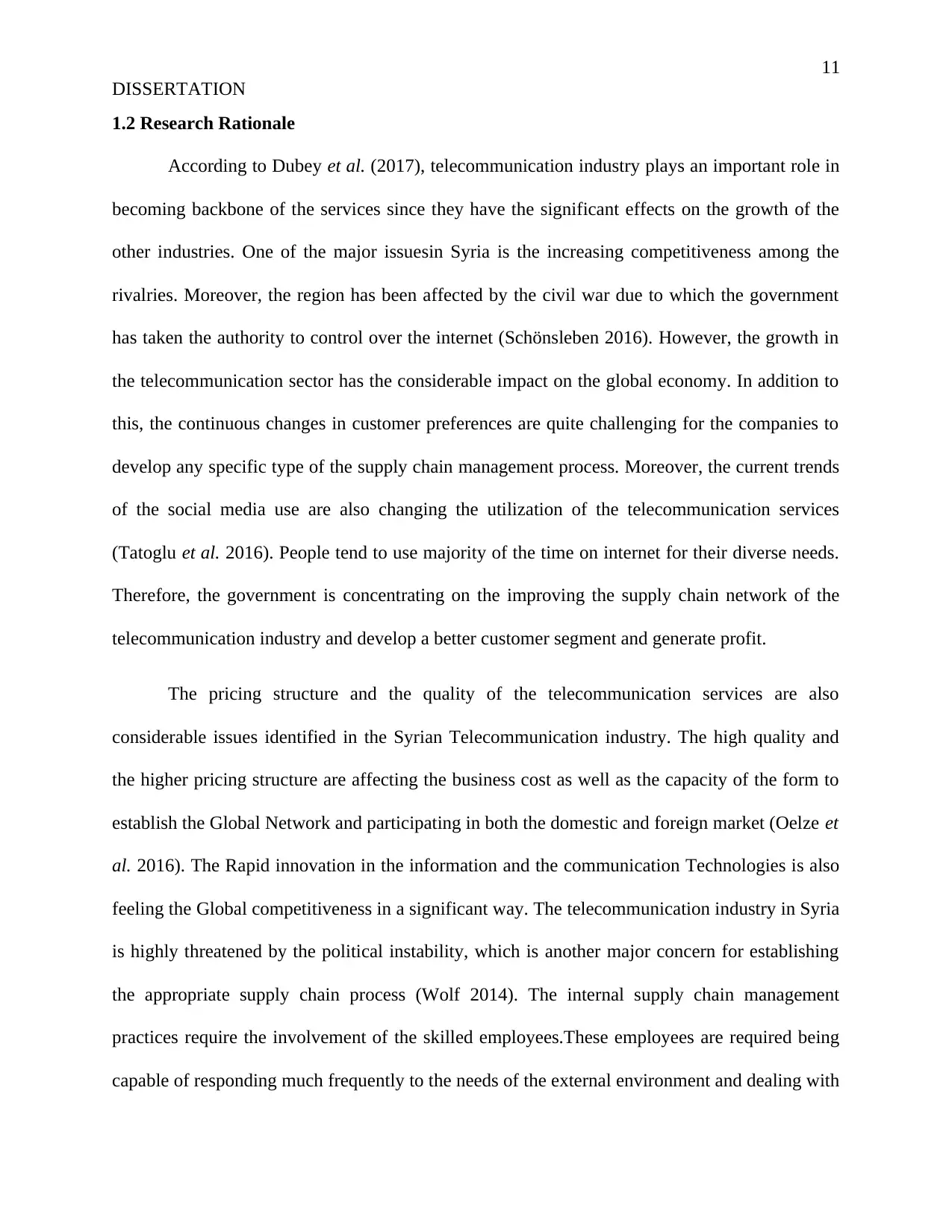
11
DISSERTATION
1.2 Research Rationale
According to Dubey et al. (2017), telecommunication industry plays an important role in
becoming backbone of the services since they have the significant effects on the growth of the
other industries. One of the major issuesin Syria is the increasing competitiveness among the
rivalries. Moreover, the region has been affected by the civil war due to which the government
has taken the authority to control over the internet (Schönsleben 2016). However, the growth in
the telecommunication sector has the considerable impact on the global economy. In addition to
this, the continuous changes in customer preferences are quite challenging for the companies to
develop any specific type of the supply chain management process. Moreover, the current trends
of the social media use are also changing the utilization of the telecommunication services
(Tatoglu et al. 2016). People tend to use majority of the time on internet for their diverse needs.
Therefore, the government is concentrating on the improving the supply chain network of the
telecommunication industry and develop a better customer segment and generate profit.
The pricing structure and the quality of the telecommunication services are also
considerable issues identified in the Syrian Telecommunication industry. The high quality and
the higher pricing structure are affecting the business cost as well as the capacity of the form to
establish the Global Network and participating in both the domestic and foreign market (Oelze et
al. 2016). The Rapid innovation in the information and the communication Technologies is also
feeling the Global competitiveness in a significant way. The telecommunication industry in Syria
is highly threatened by the political instability, which is another major concern for establishing
the appropriate supply chain process (Wolf 2014). The internal supply chain management
practices require the involvement of the skilled employees.These employees are required being
capable of responding much frequently to the needs of the external environment and dealing with
DISSERTATION
1.2 Research Rationale
According to Dubey et al. (2017), telecommunication industry plays an important role in
becoming backbone of the services since they have the significant effects on the growth of the
other industries. One of the major issuesin Syria is the increasing competitiveness among the
rivalries. Moreover, the region has been affected by the civil war due to which the government
has taken the authority to control over the internet (Schönsleben 2016). However, the growth in
the telecommunication sector has the considerable impact on the global economy. In addition to
this, the continuous changes in customer preferences are quite challenging for the companies to
develop any specific type of the supply chain management process. Moreover, the current trends
of the social media use are also changing the utilization of the telecommunication services
(Tatoglu et al. 2016). People tend to use majority of the time on internet for their diverse needs.
Therefore, the government is concentrating on the improving the supply chain network of the
telecommunication industry and develop a better customer segment and generate profit.
The pricing structure and the quality of the telecommunication services are also
considerable issues identified in the Syrian Telecommunication industry. The high quality and
the higher pricing structure are affecting the business cost as well as the capacity of the form to
establish the Global Network and participating in both the domestic and foreign market (Oelze et
al. 2016). The Rapid innovation in the information and the communication Technologies is also
feeling the Global competitiveness in a significant way. The telecommunication industry in Syria
is highly threatened by the political instability, which is another major concern for establishing
the appropriate supply chain process (Wolf 2014). The internal supply chain management
practices require the involvement of the skilled employees.These employees are required being
capable of responding much frequently to the needs of the external environment and dealing with
⊘ This is a preview!⊘
Do you want full access?
Subscribe today to unlock all pages.

Trusted by 1+ million students worldwide
1 out of 86
Related Documents
Your All-in-One AI-Powered Toolkit for Academic Success.
+13062052269
info@desklib.com
Available 24*7 on WhatsApp / Email
![[object Object]](/_next/static/media/star-bottom.7253800d.svg)
Unlock your academic potential
Copyright © 2020–2025 A2Z Services. All Rights Reserved. Developed and managed by ZUCOL.





